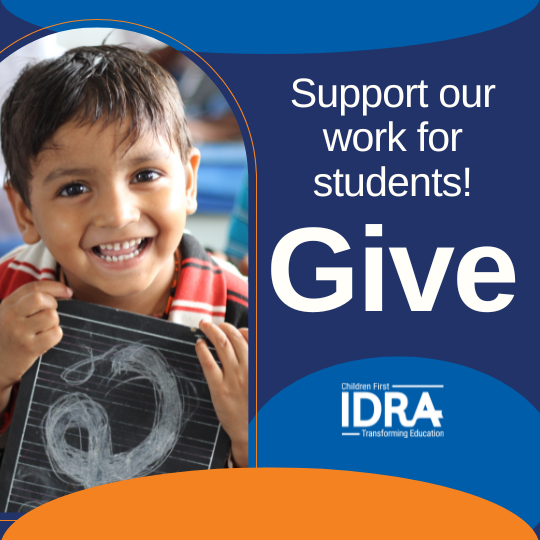• by Juanita C. García, Ph.D. • IDRA Newsletter • February 2012 •
A successful professional development program in the 21st century relies on teachers learning from each other to problem solve collaboratively, using technology devices to build their knowledge base, receiving coaching and mentoring services from model teachers, and being deeply involved in reflection and action. This article is the first in a series that will focus on these critical elements, beginning with coaching and mentoring.
Since the early 1980s, the pioneers of coaching and mentoring, Joyce & Showers, have been investigating the theory that peer coaching could be used to increase classroom implementation of training sessions. They believed that teachers who had training followed by coaching would have a higher transfer of learning rate than teachers with training only. Those early studies showed that “teachers who had a coaching relationship practiced new skills and strategies more frequently and applied them more appropriately than did their counterparts who worked alone.” (1996)
After extensive research, four principles for creating peer coaching groups have emerged as a guide for schools. The four are as follows.
- Teachers make a commitment to engage with and be part of a peer coaching team and to follow an established set of rules as a prerequisite to success.
- Successful schools have teachers who collaboratively pursue a shared vision and goals.
- Successful schools depend on members of “a village” to guide the nurturing, mentoring, coaching and supporting successful teachers in a classroom.
- Teachers plan, develop, observe and assess impact on teacher change in practice and the results on achievement of the various student groups represented in the classroom.
Today, coaching and mentoring are terms that are used interchangeably by many educators. Both take time and cannot be mastered in a one-day staff development session or in a couple of classroom demonstrations. They require a long-term commitment.
A Shared Vision
Imagine a room full of pre-kindergarten through high school teachers creating a vision for their district’s bilingual/ESL program. They have just been given directions to envision the ideal to make lasting instructional changes in their schools. They have a choice of expressing their visions in a variety of modalities: verbal, visual or musical. The richness of using several different modalities strengthens the visioning process. Each team creatively presents their vision, and then similarities and commonalities are analyzed until all agree on a vision statement.
Such a shared vision brings people together to create change when the statement is forward-thinking and visionary so that it inspires and when it is concrete enough to see and hear the future. With a well-defined vision statement and goals to be accomplished, the team now knows the direction it will take.
The Process: Nine Vital Structures
IDRA’s coaching and mentoring professional development model follows the guiding principles above as we work with teachers and their students. Our approach builds on teachers’ natural strengths, reflecting on what works and builds partnerships for success. As professional development for school teachers evolves in this 21st century, our model has a special focus on teaching practices that work in classrooms with diverse student populations, particularly low-income and minority students and students with special needs. To be effective over time, IDRA’s model stands on the following nine vital structures (IDRA, 2011).
- Developing a trusting relationship with teachers – Teachers must see the coach as someone who can “walk the talk.” The coach must have credible classroom experience, knowledge of second language acquisition and know how to work with diverse student populations. A key focus is to develop teachers’ self-efficacy.
- Creating a collaborative working plan – Mutual expectations for student achievement are discussed, roles and responsibilities established, and venues for communication set up. It needs a “whatever it takes” attitude for communicating. Coaches must find out what methods of communication work best for each of the teachers they are working with, like emails, texts, phone calls, Ning social networking sites, etc.
- Sharing classroom and teaching expectations – The coach and the team develop a mutual understanding of the observation protocol of quality teaching, that is, teachers must know they can have a profound impact on their students’ lives. They must know that the best teachers believe in their students and challenge and inspire them. They must respect and value their students’ backgrounds and strengths, incorporating them daily in profound ways into the classroom.
- Observing teachers in their classrooms – A first observation takes place to provide a snapshot of the teacher’s lesson delivery, classroom set up and needs. An optional second observation can be conducted for a progress check, and a final observation at the end of the process measures progress. It is very important that teachers trust the coach and that they don’t see him or her as a stand-in administrator who is there to evaluate them.
- Lesson modeling – The lessons incorporate instructional strategies that are based on research, especially research on what works for culturally and linguistically diverse learners. Teachers follow a lesson reflection form that is based on student motivation, cooperative grouping, language skills, higher order thinking and comprehensible input. Activities for students are performance based and are used as ways to gather information on how the students are progressing in language development.
- Reflecting and debriefing – Time is given to the observers to tell the coach what they noticed, what worked or didn’t, and how confident they feel to implement the strategies themselves. This is critical for celebrating successes, assessing problems and finding solutions.
- Co-planning with other teachers – The principal’s support is central to success by providing teachers sufficient time and resources to plan powerful dynamic lessons.
- Co-teaching – The coached teachers then become mentors to other teachers. Both collaborate in delivering instruction. Mentoring provides an opportunity for them to develop their own leadership skills and supports them in mastering instructional strategies.
- Collaborative accountability – Teachers and administrators discover new ideas and engage in continuous improvement throughout their careers.
Teachers learn by doing, reading, reflecting and collaborating with other teachers as well as by looking closely at students and their work and sharing what they see. IDRA’s coaching and mentoring professional development model can provide learners with moral support and concrete assistance. It can make teaching more public, less private and individualistic. All teachers then share responsibility for the learning of all students and spend time together on professional issues.
As a result, teachers are better equipped to meet high expectations of the school and the community, and to address linguistic and cultural characteristics of their student population. Learning never stops. It is a career-long process of developing teaching quality that ultimately leads to improved student academic performance.
Resources
IDRA. Focusing on Language and Academic Instructional Renewal (FLAIR), project materials (San Antonio, Texas: Intercultural Development Research Association, 2010).
O’Neill, T. Peer Coaching in Education, Christian Coaching Center, web page (April 26, 2010).
Showers, B., & B. Joyce. “The Evolution of Peer Coaching,” Educational Leadership (March, 1996) 53, no. 6, 14.
Villarreal, A., & K. Grayson, R.G. Rodríguez, V. Betancourt. Coaching and Mentoring for Leadership (San Antonio:
Texas: Intercultural Development Research Association, 2011).
Juanita C. Garcia, Ph.D., is an education associate in IDRA Field Services. Comments and questions may be directed to her via e-mail at feedback@idra.org.
[©2012, IDRA. This article originally appeared in the February 2012 IDRA Newsletter by the Intercultural Development Research Association. Permission to reproduce this article is granted provided the article is reprinted in its entirety and proper credit is given to IDRA and the author.]



